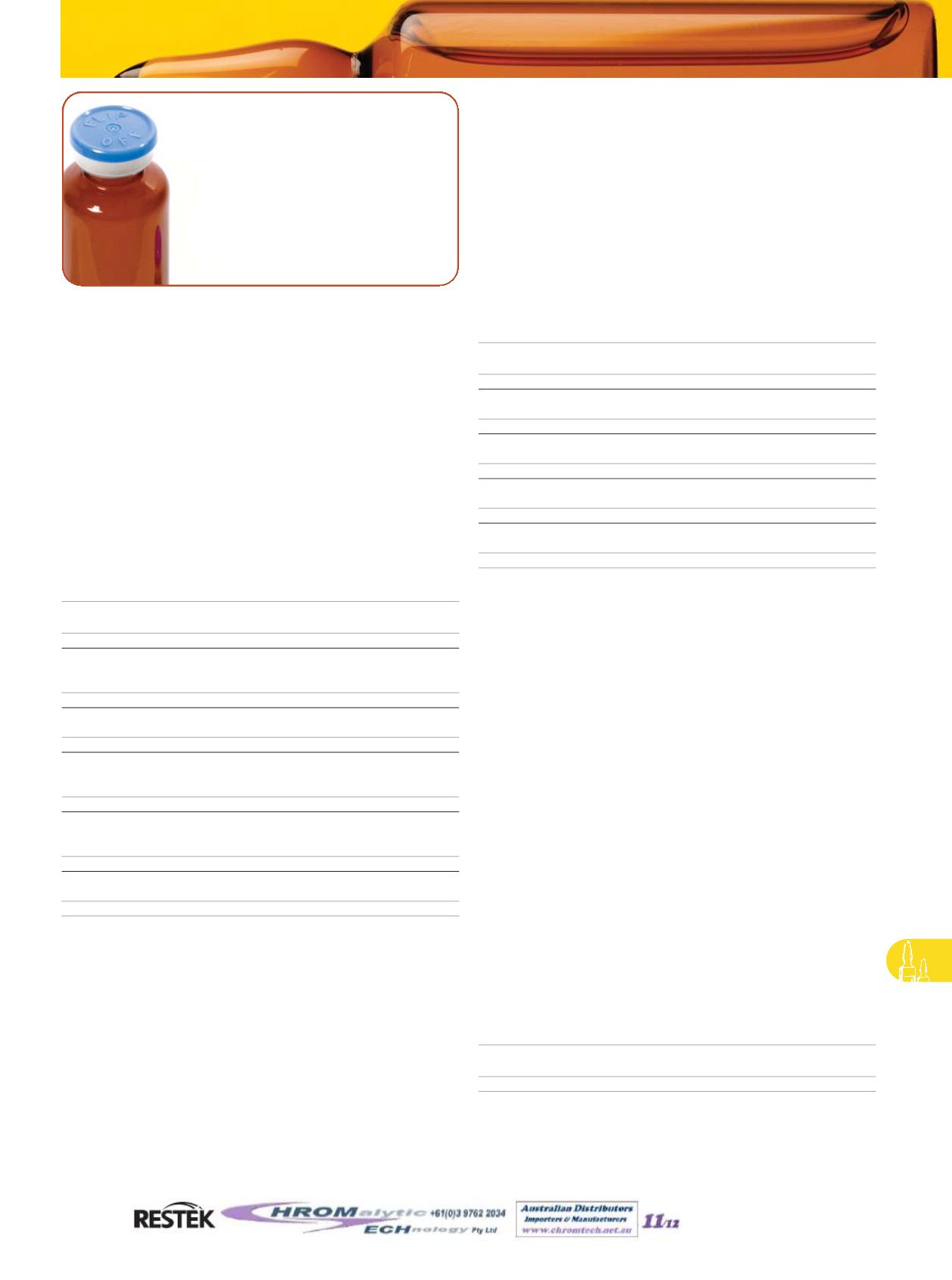
537
REFERENCE STANDARDS|
FOODS, FLAVORS & FRAGRANCES MATERIALS
Der ivat izat ion Reagents
Compound
CAS# cat.#
price
MBTFA (N-methyl-bis-trifluoroacetamide)
10-pk. (10x1g)
685-27-8
35616
25g vial
685-27-8
35617
TFAA (trifluoroacetic acid anhydride)
10-pk. (10x1g)
407-25-0
35618
25g vial
407-25-0
35619
PFAA (pentafluoropropionic acid anhydride)
10-pk. (10x1g)
356-42-3
35620
25g vial
356-42-3
35621
HFAA (heptafluorobutyric acid anhydride)
10-pk. (10x1g)
336-59-4
35622
25g vial
336-59-4
35623
PFPOH (pentafluoropropanol)
10-pk. (10x1g)
422-05-9
35624
25g vial
422-05-9
35625
Acylation Derivatization Reagents
Acylation reagents offer the same types of advantages available
from silylation reagents: creating less polar, more volatile deriva-
tives. In comparison to silylating reagents, the acylating reagents
can more readily target highly polar multi-functional com-
pounds, such as carbohydrates and amino acids. In addition,
acylating reagents offer the distinct advantage of introducing
electron-capturing groups, thus enhancing detectability during
analysis.
• Most commonly used for electron capture detection.
• React with alcohols, amines and phenols.
• Frequently used for drugs of abuse confirmation.
Compound
CAS# cat.#
price
TMPAH
10-pk. (10x1g)
1899-02-1
35614
25g vial
1899-02-1
35615
Alkylation Derivatization Reagents
Alkylation reagents reduce molecular polarity by replacing active
hydrogens, such as carboxylic acids and phenols. Alkylation
reagents can be used alone to form esters and amides or they can
be used in conjunction with acylation or silylation reagents. A
two-step approach is commonly used in the derivatization of
amino acids, where multiple functional groups of these com-
pounds may necessitate protection during derivatization.
Esterification is the reaction of an acid with an alcohol in the
presence of a catalyst. It is the most popular method of alkylation
due to the availability of reagents and ease of use. Alkyl esters are
stable, and can be formed quickly and quantitatively. Retention
of the derivative can be varied by altering the length of the sub-
stituted alkyl group. In addition to the formation of simple
esters, alkylation reagents can be used in extraction procedures
where biological matrices are present.
• Adds alkyl groups to functional hydrogens (H).
• Decreases polarity on compounds containing acidic
hydrogens, i.e., phenols, carboxylic acids.
• Forms an ester.
• Replaces active hydrogen, reducing polarity and making the
compounds more volatile.
• Increases stability of derivatives.
Compound
CAS# cat.#
price
MSTFA (N-methyl-N-trimethylsilytrifluoroacetamide)
10-pk. (10x1g)
24589-78-4
35600
25g vial
24589-78-4
35601
MSTFA w/1% TMCS (N-methyl-N-trimethylsilytrifluoroacetamide w/1%
trimethylchlorosilane)
10-pk. (10x1g)
24589-78-4
35602
25g vial
24589-78-4
35603
BSTFA (N,O-bis[trimethylsilyl]trifluoroacetamide)
10-pk. (10x1g)
25561-30-2
35604
25g vial
25561-30-2
35605
BSTFA w/1% TMCS (N,O-bis[trimethylsilyltrifluoroacetamide]
w/1% trimethylchlorosilane)
10-pk. (10x1g)
25561-30-2
35606
25g vial
25561-30-2
35607
MTBSTFA w/1% TBDMCS (N-methyl-N[
tert
-butyldimethylsilyl trifluoroacetamide]
w/1%
tert
-butyldimethylchlorosilane)
10-pk. (10x1g)
77377-52-7
35608
25g vial
77377-52-7
35610
TMCS (trimethylchlorosilane)
10-pk. (10x1g)
75-77-4
35611
25g vial
75-77-4
35612
Silylation Derivatization Reagents
Silylation is the most widely used derivatization procedure for
sample analysis by GC. In silylation, an active hydrogen is
replaced by an alkylsilyl group such as trimethylsilyl (TMS) or
tert
-butyldimethylsilyl (
tert
-BDMS). Silyl derivatives are more
volatile, less polar, and more thermally stable. As a result, GC
separation is improved and detection is enhanced.
Both TMS and
tert
-BDMS reagents are suitable for a wide vari-
ety of compounds and can be used for many GC applications.
Note that silylation reagents are generally moisture sensitive and
must be sealed to prevent deactivation.
Derivatization
Reagents
• Reagents available for acylation,
alkylation, and silylation.
• Packaged in 10 x 1 g vials or 25 g vials.
• High purity for accurate results.
Website :
E-mail :
TelNo : 03 9762 2034 . . . in AUSTRALIA
Mar 2011


